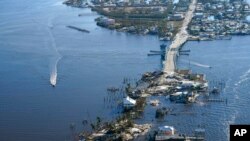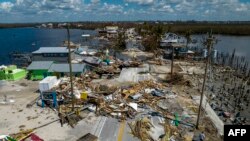Brandie Rae Chapman was at home in Fort Myers Beach – a tiny island town – when she learned a rapidly strengthening Hurricane Ian would hit southwest Florida last week as a Category 4 storm.
Grabbing her dog and cat, Chapman opted to abandon her late father’s house and evacuate, a decision that may have saved her life.
When she returned days later, Chapman was in shock.
“Water reached the roof on the outside, and was four feet high on the inside,” she told VOA. “Everything I own was in that home, including a lifetime of family memories. It’s heartbreaking. My dad’s house, our neighborhood – our entire island, really – is just gone.”
Days after Ian made landfall in the United States with sustained winds of more than 240 kilometers an hour, the death toll from the storm continues to rise, as do damage estimates running in the tens of billions of dollars. Hundreds of thousands of Floridians remain without electricity and internet as search and rescue operations have pivoted to relief and recovery efforts.
Americans mobilize to help
Nina Phelps is volunteering with the United Cajun Navy, a Louisiana-based relief group that formed during Hurricane Katrina in 2005 and responds to disasters by helping with search and rescue efforts, getting essential supplies to victims and assisting with recovery efforts. She sees a long and painful road ahead for hurricane-battered areas, especially the island communities Ian pummeled.
“People in this area are finding parts of their home a mile away from where it should be,” she told VOA. “Boats are in the middle of the road, and on stretches of the coast I’d say 85% of homes are destroyed. Even the 15% that aren’t still have roof damage, which means the homes probably need to be gutted. This recovery will definitely take a year if not longer.”
The American Red Cross says more than 1,300 workers are supporting disaster relief efforts in Florida and elsewhere. Phelps said the need for assistance is overwhelming.
“What these people have gone through over the last few days, and what they’re going to be going through in the next months,” she said, shaking her head, “we just want to be here to help them get through it and to rebuild their lives as best as they can.”
Unexpected intensity
Ian is blamed for more than 100 deaths in Florida, with most casualties centered upon the southwestern part of the state.
Critics allege state and local authorities waited too long to order a mandatory evacuation of coastal areas in the hurricane’s path, giving some residents insufficient time to flee and leaving them no choice but to try to ride out the approaching storm in their homes. In response, officials note that, 72 hours before Ian’s expected landfall, weather models showed many islands and coastal communities outside the center of the storm’s projected path.
Margaret Pichon counts herself lucky. She was able to evacuate a coastal home in time and had a safe place to take shelter in Naples, Florida.
“As the storm got closer, I had other family members telling me I had to get out of there,” she recalled. “Things were getting scary, so I decided to leave and stay with my mom at her nursing home.”
But Pinchon notes that others in her community decided to stay.
“One woman was too afraid to leave, so on the night of the hurricane her son biked more than four miles in a Category 4 storm so he could at least spend the night with his trapped mom,” she told VOA. “He said water was up to his waist as he got into the neighborhood.”
Pinchon added, “You can see the water line on the buildings – where the water rose to, and everything is covered in mud and debris now for miles. I just don’t think a lot of people expected it to be this bad.”
Answering the call
As Hurricane Ian gathered strength over the Gulf of Mexico’s warm waters, emergency organizations issued pleas for volunteers and aid.
Phelps answered the call, driving from her home in Kentucky and braving the incoming storm as she approached the Florida coast.
She said more than 100 other volunteers joined her in the United Cajun Navy camp as the hurricane subsided. Hurricane victims began showing up, as well.
“One guy – his name was Mike – came up to me, dragging a canoe,” Phelps remembered.” He told me he was at home during the hurricane until his house flooded. His last option was to leave in the middle of the storm and jump into his canoe, getting tossed around for hours.
“The most amazing part,” she continued, “is he said, 'This boat saved my life, so now I want you to take it to save others.’ He gave me his last possession and then joined us volunteers as we began our rescue efforts.”
The United Cajun Navy said they have received thousands of requests for assistance in southwestern Florida. Some of those requests are for wellness checks from people who haven’t heard from loved ones because electricity is out, and roads and bridges are blocked, unusable, or destroyed.
The group has rescued stranded people and – in some cases – discovered bodies of deceased storm victims. Rescue workers are marking the doors of houses with an “X” and noting the number of individuals saved and any bodies encountered. For volunteers who experienced past deadly storms such as Hurricane Katrina in 2005, those markings dredge up bad memories and are an ominous sign.
“It’s been a difficult week and an emotional rollercoaster,” Phelps said. “When you have bodies in an area with projectile debris, as well as flooding and alligators, you can find some pretty terrible things.”
“There have been rewarding moments, as well, though,” she added. “We took the boat across to one of the islands to recover the bodies of an elderly couple and when we got to their house, they were still alive, along with their black Labrador. They managed to survive and now we were ferrying them back to be reunited with their family.”
Long road ahead
For many in southwest Florida, including Chapman, whose father's home is uninhabitable, recovery will not be a short-term proposition.
“I need a new place to live, and I need a new job to make money to pay that rent,” she said. “I don’t even know where to start.”
Survivors of previous hurricanes know firsthand the struggles that lie ahead for countless people who suffered property damage as a result of Ian: potential battles with insurance companies to cover rebuilding costs and long waits to get the work done.
The devastation has likely worsened the housing crisis in Florida. Even before the storm, the Florida Housing Coalition, a nonprofit group, estimated the state had a deficit of 500,000 homes for lower- and middle-income families.
“I didn’t even know where I would be sleeping tonight,” said Chapman, who is attempting to raise funds for essential supplies and lodging on GoFundMe, an online crowdfunding platform. “Hotels are booked, for hours in every direction. Airbnb owners are price gouging. My only option was to sleep in my car, and I know I’m not the only one in that situation.”
Chapman said she is trying to rebuild her life a day at a time. She later received the first good news in a heart wrenching week.
“I found a place to stay,” she said, beaming. “An older woman said she’d help me by dropping the price of her rental. I know I have a long way to go, but for now, I am so happy I could cry.”











